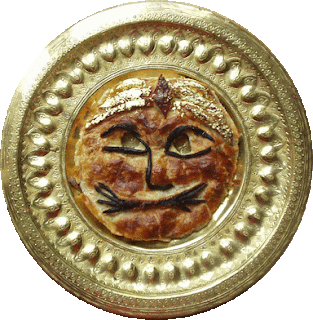Below is a small article about an old dish from the medieval era called Turk's Head. Following the article is a recipe:
TURK'S HEAD PIE
I believe many would be surprised to learn that Turk's Head Pie is a basic meat dish made from leftover game meat. The origin of the dish's name is pleasant and a lot more complicated. Turk's Head Pie originated probably during the Crusades. European armies that fought during those wars - probably Norman - fed its soldiers by baking leftover game in pastry shells or crusts. These armies named the dish after their enemy - the Muslim soldiers that were known as "Turks". Judging by the simple recipe, the Europeans did not mean to be complimentary.
The oldest version of the Turk's Head pastry recipe can be found in an Anglonorman (Norman or French) manuscript from the 14th century. There is an even older recipe called "Teste de Turk" from an older Anglonorman manuscript dated 1290. However, this recipe is not a pasty. Instead, it calls for a pig's stomach stuffed with pork, chicken, saffron, eggs, bread and almonds before it is boiled.
The original recipe, which can be found in "Two Anglo-Norman culinary collections edited from British Library manuscripts Additional 32085 and Royal 12.C.xii": Speculum 61 (1986):
Turk's Head
A sheet of dough, well filled(?): much in it, rabbits and birds, peeled dates steeped in honey, a lot of new cheese in it, cloves, cubebs, and sugar on top. Then a very generous layer of ground pistachio nuts, colour of the layer red, yellow and green. The head shall be black, dressed with hairs in the manner of a woman on a black dish, the face of a man on it.
Here is a more updated version of the recipe:
Turk's Head Pie
Ingredients
300 gram (2/3 pound) minced meat (pork or veal) (optional)
4 hindquarters of a wild rabbit (or one rabbit)
4 quails, or 2 partridges or pheasants
2 Tbsp. sugar
1/4 tsp. ground cloves
1 tsp. ground cubeb (or black pepper with a little piment)
200 gram (1 1/4 cup) dates
200 gram (3/4 cup) young, fresh cheese (sheep, goat, cow)
200 gram (1 1/2 cup) pistachio's without shells
60 gram (2 Tbsp. or 1 fl.oz) honey
lard, suet or butter
salt
dough for pasties
1 egg (optional)
Preparation in Advance
Fry the minced meat in lard, suet or butter.
Sprinkle rabbit and fowl with peper and salt. Heat lard, suet or butter in a large skillet, brown the meat quickly, then cover and simmer until it is done (about forty minutes). You can also roast the meat in the oven, baste regularly with the fat (suet, lard, butter). When it is done, let the meat cooluntil you can easily debone it. Cut into large chunks.
Steep the stoned dates five to ten minutes in honey that is heated with two tablespoons of water. Drain the dates, but keep the honeywater. Cut the dates in quarters.
Crumbe the cheese, or chop it.
Put everything in a bowl - minced meat, rabbit and fowl, spices, chees, dates, sugar and honeywater, mix well.
The crust - make a pasty dough, or use some ready-made if you really think you must. But making your own is more fun, and you get a special dough.
Preparation
Heat the oven to 200 degrees (400 degrees Fahrenheit).
Take a springform or a pie dish that is large enough to contain the stuffing (that depends on how large your rabbit and fowl were, whether or not you added minced meat, or how much leftovers you had). Grease the form with butter and roll out your dough. Place the dough in the piedish. If you use a springform, it is best to assemble the pasty: first cut out the bottom out of a rolled sheet of dough and place that in the springform. Then cut a long strip of dough, a little broader than the springform is high, and cover the sides. Be sure to seal the side to the bottom sheet of dough by gently pressing the edges togehter. If you want to be sure, roll a thin strip of dough between your palms and press that against the edges. Let the dough that hangs over the top of the form be, you'll use that to seal the cover.
Scoop the stuffing into the dough, cover with pistachio nuts. Close the pasty or pie with another sheet of dough. Press the edges of the cover and the sides together and cut out a small hole or two to let the steam escape. You can incorporate these holes into your decoration (eyes, mouth).
Now the name of the pasty becomes clear - use leftover dough to decorate the cover with a 'Turk's head' or something else. Colouring and gilding is done after baking, but you can baste the dough with eggwhite (for a light glaze) or egg yolk (for a darker glaze).
Put the pasty or pie in the middle of the oven, bake for about forty minutes. Let cool five minutes after taking it from the oven befor demoulding.
To finish the decoration apply food colouring paste with a small brush, and gold leaf or silver leaf.
To Serve
A pasty like this one can be served hot as well as cooled to room temperature. Cut the cover loose and lift it, and scoop out the stuffing. When eating the medieval way, you use your fingers to pick what you want, and eat it above your bread trencher.




No comments:
Post a Comment